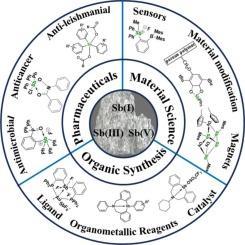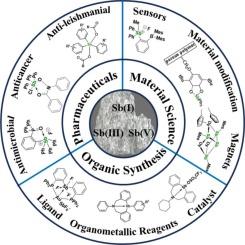Synthesis and application of organostibines
IF 23.5
1区 化学
Q1 CHEMISTRY, INORGANIC & NUCLEAR
引用次数: 0
Abstract
The present review comprehensively surveys the current applications of organostibines, covering the chemical, biological, and materials sectors. In the field of chemistry, the preparation processes of organostibines are described, including metal reagent exchange and catalytic methods for the synthesis of different Sb-Z (Z = C(sp, sp2, sp3), O, S, N) bonds. Additionally, the applications of related organostibines as metal reagents, organometallic ligands, and catalysts are also described, and the corresponding schematic mechanisms are summarized to facilitate further research on organostibine derivatives from this class of compounds. In the biological field, organostibines serve as vital drug molecules in treating leishmaniasis, cancer, and bacterial infections. Furthermore, they are effective in the repair of blood vessels and the transportation of fluoride ions. Materials science is employed in the detection of fluoride ions, the modification of ceramic surfaces, and the alteration of polymer viscosity. By providing a comprehensive overview of organostibines, we can offer researchers direction and a research focus for subsequent developments and applications in antimony chemistry, thereby promoting its vigorous development.


有机斯蒂宾的合成与应用
本文综述了有机刺碱在化学、生物和材料等领域的应用现状。在化学方面,介绍了有机硅氧烷的制备工艺,包括金属试剂交换和催化合成不同的Sb-Z (Z = C(sp, sp2, sp3), O, S, N)键的方法。此外,还介绍了相关有机辉宾作为金属试剂、有机金属配体和催化剂的应用,并总结了相应的原理机制,为进一步研究该类化合物衍生的有机辉宾衍生物提供了基础。在生物领域,有机斯蒂宾是治疗利什曼病、癌症和细菌感染的重要药物分子。此外,它们对血管的修复和氟化物离子的运输是有效的。材料科学应用于氟离子的检测、陶瓷表面的修饰和聚合物粘度的改变。通过对有机锑的全面概述,可以为后续在锑化学领域的开发和应用提供研究方向和研究重点,从而促进其蓬勃发展。
本文章由计算机程序翻译,如有差异,请以英文原文为准。
求助全文
约1分钟内获得全文
求助全文
来源期刊

Coordination Chemistry Reviews
化学-无机化学与核化学
CiteScore
34.30
自引率
5.30%
发文量
457
审稿时长
54 days
期刊介绍:
Coordination Chemistry Reviews offers rapid publication of review articles on current and significant topics in coordination chemistry, encompassing organometallic, supramolecular, theoretical, and bioinorganic chemistry. It also covers catalysis, materials chemistry, and metal-organic frameworks from a coordination chemistry perspective. Reviews summarize recent developments or discuss specific techniques, welcoming contributions from both established and emerging researchers.
The journal releases special issues on timely subjects, including those featuring contributions from specific regions or conferences. Occasional full-length book articles are also featured. Additionally, special volumes cover annual reviews of main group chemistry, transition metal group chemistry, and organometallic chemistry. These comprehensive reviews are vital resources for those engaged in coordination chemistry, further establishing Coordination Chemistry Reviews as a hub for insightful surveys in inorganic and physical inorganic chemistry.
 求助内容:
求助内容: 应助结果提醒方式:
应助结果提醒方式:


